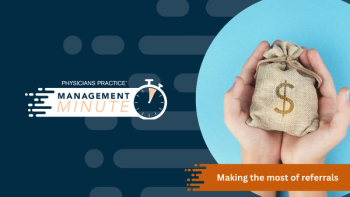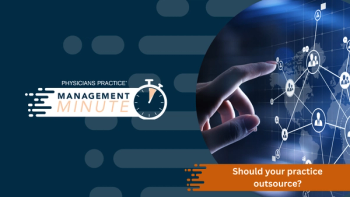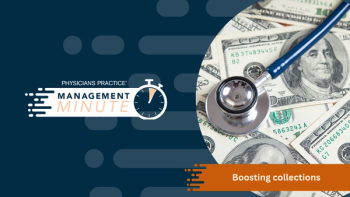
Managing Medical Necessity
What do payers know about medical necessity anyway? Reduce those annoying denials and collect what you deserve.
Claim denials are annoying and costly. But denials for medical necessity seem especially frustrating. What do payers know about what is medically necessary anyway? Isn't that the physician's job to decide?
Here's the good news. You can reduce medical necessity denials relatively easily. And most such denials aren't really about payers saying they think they know better than you. More often than not, it's a matter of sloppy diagnosis coding or billing errors.
Here's how to get better.
Code and Link Accurately
Ninety-nine percent of medical necessity denials happen because diagnosis codes (ICD-9 codes) on the claim don't match up with procedural codes (CPT codes), according to Lisa Souba, a consultant with LSA Practice Management and Coding Services in Breckenridge, Colo.
"If you think about the CMS 1500," offers consultant Mary Jean Sage, by way of explanation, "you can list up to four different diagnosis codes in Box 21. Then down in Box 24, you list the CPT codes. In line 24E, you bring pointers down from Box 21." The codes in the boxes need to link up. Sage is with The Sage Group in Pismo Beach, Calif.
Imagine if you saw a claim that indicated the patient was suffering from an ear infection, but the procedure coded was for an EKG. You'd know right away that something was wrong; that's what payers see, too.
Most aren't this obvious, of course, but it is easy for a physician treating a patient with multiple diagnoses to forget to note one of them. That forces billers to try and guess what to fill in the blanks. "It's pretty amazing what people come up with for diagnoses. The physician knows what he or she is doing, but staff may not code to the highest specificity or may select a code that is altogether inappropriate," says Joan Elfeld, a consultant with Medical Practice Support Services in Denver.
Errors also happen because of lack of specificity, says Souba. "Sometimes we'll see where signs and symptoms aren't covered diagnoses for the service, but the actual condition is. The physician[s] won't get specific with their diagnoses."
For example, injection of the tendon sheath, CPT 20550, might get denied if paired with ICD-9 code 719.47 for pain in the foot. But it would sail through if paired with 729.4, fascitis.
Also, under-informed billing staff may not know which diagnosis or symptom goes with what service. Whether you are doing electronic billing or using a CMS 1500 paper form, each diagnosis code needs to be linked to a CPT code on the claim. Usually they are entered in the same order so it's clear which service was meant to help which problem. Someone who doesn't understand the clinical side of the practice - such as your biller - might match a diagnosis with a procedure that upon reflection doesn't make sense.
"Physicians really need to be specifying what diagnosis they are doing for what procedures. The physicians need to be giving the coder all the pertinent information," suggests Rex Stanley, CEO of coding book publisher Unicor Medical, Inc., and a consultant based in Montgomery, Ala.
Open lines of communication help. Coders and billers need to feel free to ask physicians follow-up questions based on their documentation. In many practices, staff are afraid to approach physicians.
It might also be useful to hold regular educational sessions for all staff about the clinical services the practice provides, especially when a new procedure or service is adopted. Souba also recommends tracking denials by physician or even by procedure so that education can be more targeted. "Identify what it is that is missing, and then it's just a matter of sitting down and really doing the communication," she says.
Conquering NCDs and LMRPs
It's relatively easy to manually catch some odd ICD-9/CPT combos - the ear infection plus EKG, or even the ear infection plus well-child visit - but some matches that trigger denials are more obscure. Mismatches can also occur because of failure to follow the dreaded Local Medical Review Policies (LMRPs) or National Coverage Determinations (NCDs).
LMRPs are essentially each Medicare carrier's rules for what services are allowed for what diagnoses. Those rules are coded into a database which automatically denies any claim violating the rules. That means that if you submit a claim with a pairing that your carrier's database doesn't permit, it is kicked back to you as a denial. This is done automatically. Don't imagine there is a person there judging your treatment plan.
There can be dramatic differences from one carrier to the next as far as what is allowed. Rules vary among carriers, says Stanley. Making things worse, carriers have realized how wildly out of date and inaccurate their databases can be so they are constantly changing them, Stanley adds. That means a claim that flies through and gets paid this month, might get rejected next month.
LMRPs have been around since the late 1990s. The newer NCDs provide a national standard for the minimum of what must be covered by each carrier. There are 23 policies, each covering anywhere from six to 20 different types of diagnostic tests, mostly lab work. While slightly more standardized than the chaotic LMRPs, there is still plenty of confusion to be had as states can add on to NCDs as they wish. The NCDs represent a nationwide minimum, but states can cover more, explains Stanley.
(Since the advent of NCDs, LMRPS are now sometimes called LCDs, or local coverage determinations, for those of you trying to keep your acronyms straight.)
And that's just for Medicare. Commercial payers roughly follow Medicare, but also make up their own rules on what is OK to do for every possible diagnosis.
Together, all these policies typically cover about 17 percent of all CPT codes, Stanley says. This means that most of the time, the CPT codes you bill are not really being checked for medical necessity through the onerous NCD/LCD databases. "Of course, it only takes a couple of them" to cause big problems, says Stanley. "Medicine is such a repetitive thing" - you tend to order the same lab work several times a day so errors add up, he says. "And it's not like the good old days when there was tons of money in healthcare. Seventeen percent can have a big impact."
All commercial carriers are now required by law to have their coverage determinations posted on their Web site, somewhere, so you can try to keep up with them. And you can find Medicare's online, too. Just go to
But in a frenzied medical practice, there's no time to cross-check every diagnosis, especially since this really should be done before the service in question is performed. If a diagnostic test is not considered a medically necessary service by Medicare, but the physician wants it done anyway, the patient should sign an advance beneficiary notice (ABN) before the service is performed. The notice lets patients know they likely will have to pay for the tests themselves.
Commercial payers, generally, also allow ABNs, letting practices collect from patients for uncovered services, assuming the patient was warned in advance, says Souba.
Even if your goal is simply to make sure the codes match up before sending out claims, it's a lot of work to check them manually. That is where software comes in.
Vendors are embedding NCD/LCD edits into EMRs and claims management software. With an EMR, a physician ordering lab work gets a warning if the test he orders is not considered medically necessary for the diagnosis entered. The diagnosis can then be changed, or ABN can be printed then and there. Later in the process, claims-scrubbing tools review electronic claims before they are sent and flag those that violate the NCD/LCD requirements. The biller can then grab the chart or the physician to see if the diagnosis is accurate and aligned properly with the service in question. Some vendors update the edits monthly, quarterly, or annually.
Nancy Babbitt, administrator for Roswell Pediatric Center in Alpharetta, Ga., swears by her system. "Prior to the EMR, if we did a strep test and a well-child diagnosis, nine times out of 10, we wouldn't catch it manually. Now, the doctor goes to order on the chart, and the EMR signals that there is no diagnosis code to support the procedure code. The size we are, it's hard to keep that many people updated on the rules and guidelines. It's just human nature [to miss things manually]. You want to get everything through and done and out. It's terrible to have payment denied." Babbitt's nine-physician practice uses an EMR from Noteworthy Medical Systems.
Complying with Coverage Policies
The other major cause of medical necessity denials involves timing of services and procedures. For example, Medicare covers a mammogram screening once every 12 months, which is measured from the month after the mammogram was previously done. If a patient comes in for a mammogram 10 and a half months after her last one, Medicare will deny the claim. These time periods most often apply to preventive services.
Well-educated staff can catch many of these potential problems by performing pre-appointment eligibility checks online at payer Web sites. Schedulers also can ask patients making appointments for annual exams, Pap smears, preventive colonoscopies, and so on, to call their insurance company before coming in to confirm the service will be covered on the date of the patient's visit. Sage worked with one practice that kept a phone in the waiting room specifically for this purpose. If patients showed up and had not done their own verification, the front-desk staff asked them to use the phone to call the 800 number on the back of their insurance cards. Nurses previewing charts or doing the initial work-up of patients can also learn about the basic rules of major payers and request an ABN from the patient if there is a problem.
If there is any question, Sage suggests charging the patient for the visit and refunding the money if the payer does end up accepting the claim.
How to Appeal
All the planning in the world won't eliminate every medical necessity denial, of course, so it's wise to consider when to appeal. "My personal experience is that most people don't appeal a lot on medical necessity," comments Stanley.
Sage agrees. "Far too often practices just don't think it's worthwhile and they end up writing it off. ... The appeal can work."
Practices are partly reluctant to appeal, notes Andy Kapit, CEO of CodeRyte, because the diagnostic tests so heavily covered by LCDs and NCDs pay so little, that the cost of doing a chart pull and putting staff time on the appeal may not seem worth it. It's better to try to catch mistakes before they happen.
Still, your claims may be getting denied for common reasons, so consider making an effort. Stanley says one of his key consulting tactics is to wander through a client's office looking for the drawer - most practices have one - stuffed with denied claims that someone will get to "when they have the time." He calls it the "Porsche drawer" - as in if you ever do appeal those claims and get paid, you'll have enough cash to buy a Porsche. Don't let it get to that point.
Stanley also notes that appealing the logic of an LCD edit can be surprisingly successful. He estimates appeals are successful about 87 percent of the time. "So frequently, they [the payers] are denying things that are medically appropriate because databases are of such poor quality. These things should be challenged," Stanley says.
And there is a bonus - Medicare rules say that payers that overturn a denial based on an appeal from a provider have to make the change permanent in their databases, notes Stanley. Your appeal may actually improve the system, and that means you won't have to write another appeal letter on the same topic to the same payer more than once.
If you do appeal, be sure to address the issue at hand, says Elfeld. If the issue is an LCD, send documentation from medical literature spelling out why the constraint is inappropriate. Your letter should likewise specifically address the LCD. Don't get distracted by the "injustice" of the situation and fail to properly interact with the payers. Elfeld saw one practice with a patient who had more chemotherapy treatments within a given time frame than her payer allowed. The practice's appeal letter simply explained the patient's medical status warranted the treatments, Elfeld says. But payers don't adjudicate based on sentiment. They may reconsider a silly combination in the LCD database.
"If you are having trouble with a particular service, find someone at the payer you can address your claims to," advises Sage. Research the utilization review department at the payer, typically made up of physicians who act as consultants. Look for someone with background in your specialty and send your appeal directly to her. Also familiarize yourself with the review process each payer is required to post online - it may be worthwhile to push your appeal through every stage if you really believe the service should be covered.
Here is another appeal letter suggestion, from Elizabeth Woodcock, author and speaker with Woodcock & Associates, Atlanta: Quote the payer's own definition of medical necessity. Most insurance companies, online or in brochures or contracts, provide an explanation of what they consider medically necessary and will cover. Use their own words against them, in a sense, by quoting their promise in your appeal.
Pamela Moore, PhD, CPC, can be reached at
This article originally appeared in the November/December 2005 issue of Physicians Practice.
Newsletter
Optimize your practice with the Physicians Practice newsletter, offering management pearls, leadership tips, and business strategies tailored for practice administrators and physicians of any specialty.














